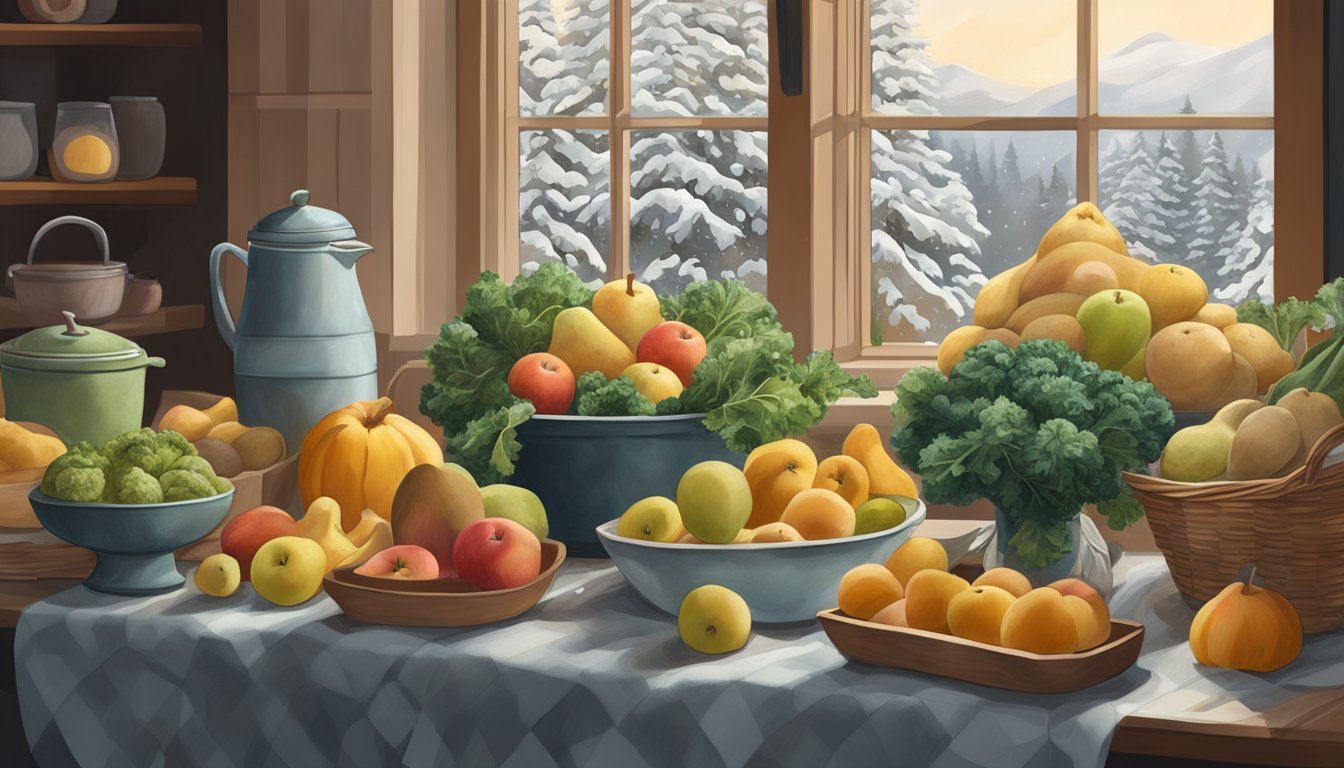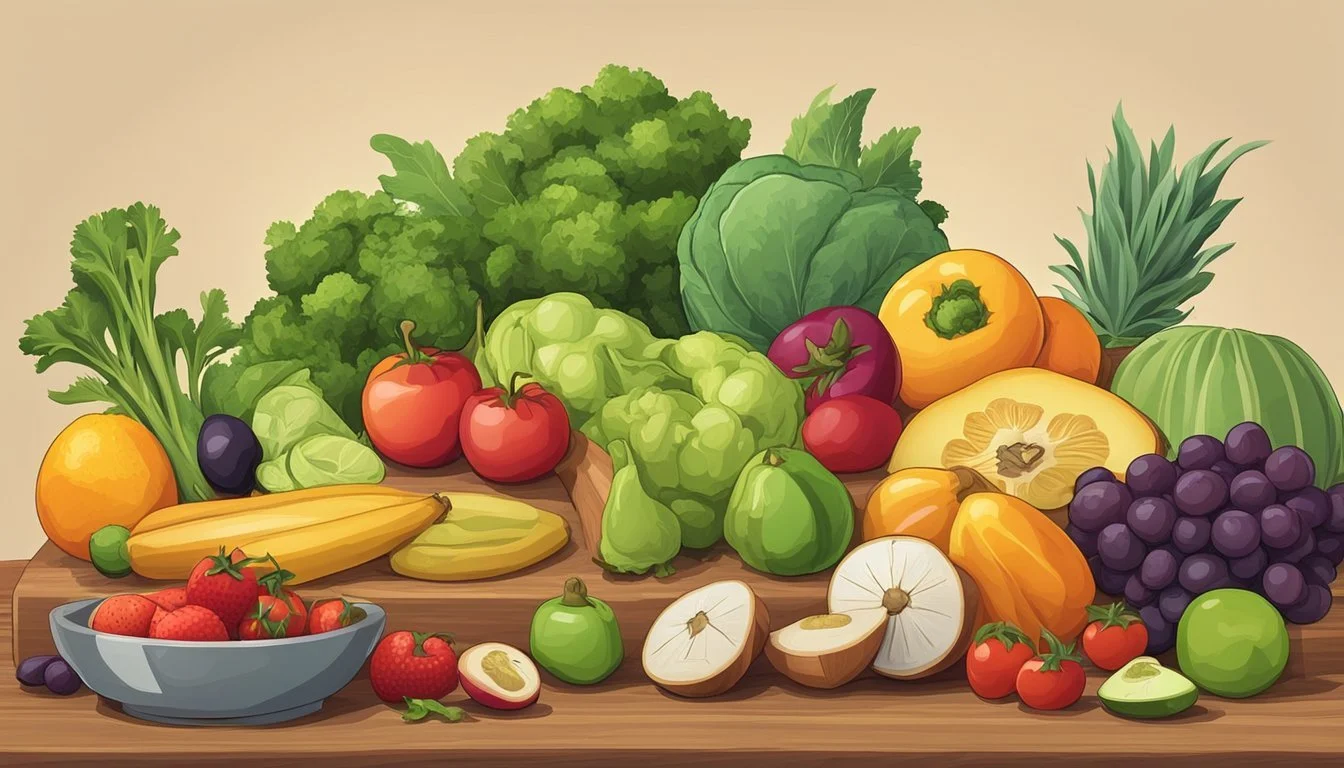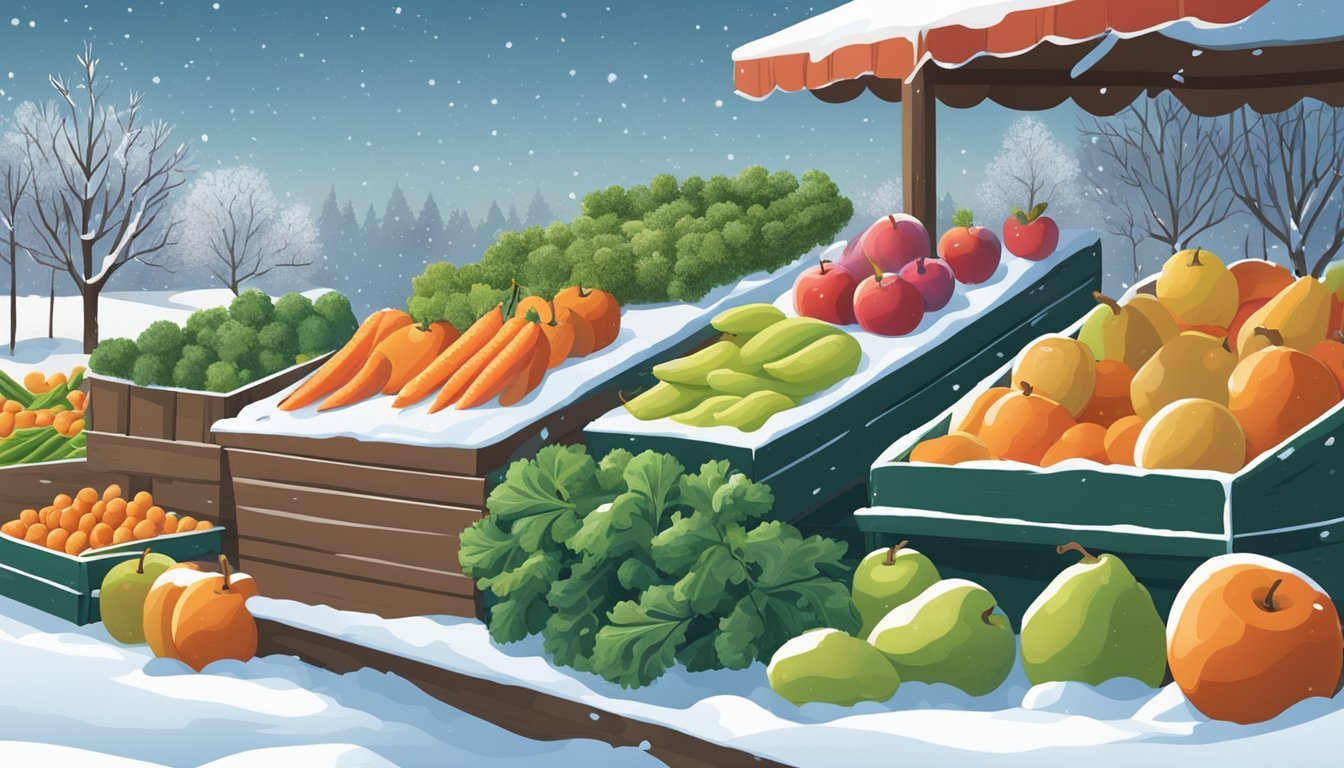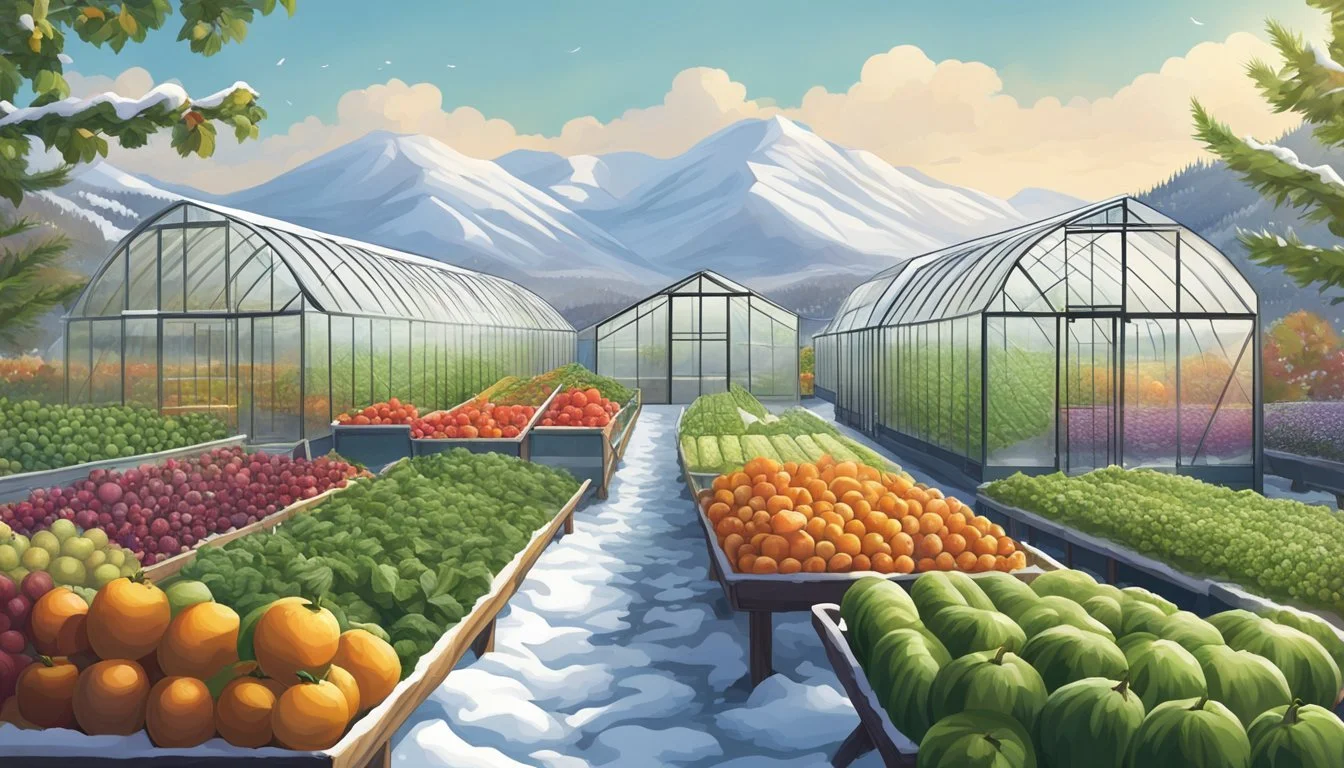West Virginia Seasonal Fruit & Vegetables in December
A Guide to Winter Produce
This Article is Part of our West Virginia Seasonal Fruit & Veg Calendar
In December, the landscape of West Virginia takes on a winter hue, and the options for fresh, seasonal produce shift accordingly. The cooler temperatures and shorter days influence the types of fruits and vegetables that can be harvested during this time. Locally sourced produce can be limited, but what is available is often characterized by robust flavors and hearty textures suited for winter's demanding climate and the region's culinary traditions.
Residents and chefs in West Virginia turn to seasonal selections that thrive in the chill of December. These offerings typically include cold-weather crops that have adapted to survive frost and lower temperatures. The month's seasonal produce is often ideal for warm, comforting dishes and holiday recipes, reflecting West Virginia's emphasis on home cooking and family gatherings around the table.
Peak Seasonal Produce in West Virginia
In West Virginia, December brings a limited but flavorful selection of fruits and vegetables, characterized by hearty root vegetables and a few fruit options that can withstand the cold winter temperatures.
Overview of December Fruits
West Virginia's winter climate limits the variety of fruits available in December. However, some fruits are in season:
Apples: Various types of apples continue to be available from the fall harvest.
Pears: Like apples, pears are also harvested in the fall but are still fresh and available in December.
Persimmons: December is the tail end of the persimmon season in West Virginia.
Clementines and Oranges: While not typically grown in West Virginia, these citrus fruits are often at peak flavor during winter months due to imports from warmer states.
Overview of December Vegetables
Winter's chill welcomes a robust selection of vegetables that thrive in colder weather or store well after fall harvests:
Winter Squash: Varieties like acorn and butternut are in good supply having been harvested before the first frost.
Kale: Hardy greens such as kale can survive winter's onset and are often harvested during this month.
Root Vegetables:
Potatoes: A staple storage crop, potatoes are readily available.
Carrots: This root vegetable remains sweet and crisp in winter.
Turnips: Harvested in fall but available into winter due to their good storage capabilities.
Cabbage: Often at its best in colder months.
Brussels Sprouts: Typically harvested in the fall, they can continue to be available through early winter.
Celery Root (Celeriac): A lesser-known root vegetable with a flavor profile akin to celery.
Benefits of Seasonal Eating
Seasonal eating in West Virginia offers a range of benefits from increased nutritional value to enhanced flavor and freshness. Consuming fruits and vegetables in their peak season can optimize one's diet.
Nutritional Advantages
Seasonal fruits and vegetables often contain higher levels of vitamins and minerals. For instance, during the summer, produce like strawberries are rich in fiber and vitamin C. In the fall, pumpkins provide a good source of iron and beta-carotene. Consuming these items raw can retain more nutrients, supporting a more nutritious diet.
Flavor and Freshness
Produce harvested in its proper season typically offers superior flavor. This is because they are picked at the peak of their ripeness. The fresh taste is most noticeable in summer when fruits like watermelons are at their juiciest, and in fall, when the natural sweetness of root vegetables like carrots is at their best. The freshness of seasonal produce means they haven't been stored for long periods, which can diminish taste and texture.
Preparation and Cooking Tips
Winter in West Virginia brings a different bounty to the table, one that can transform comfort food and holiday favorites with rich flavors and textures. Emphasizing seasonal produce in dishes not only offers the freshest taste but also aligns with sustainable eating practices.
Winter Vegetable Recipes
Soups and Stews: The chill of winter makes it a perfect time for warming soups and hearty stews. Vegetables such as rutabagas and sunchokes contribute a robust flavor to these dishes. They can be peeled, cubed, and added to stews with meats or other root vegetables. For soups, they can be sliced thin and simmered until tender. Incorporating these vegetables into a winter stew or soup not only adds depth of flavor but also increases the nutritional content.
Roasted Vegetables: (What wine goes well with roasted vegetables?) Roasting vegetables is a simple way to enhance their natural sweetness. Brussels sprouts, carrots, and sweet potatoes can be cut into consistent sizes for even cooking, tossed with a little olive oil and seasoning, and then roasted in a preheated oven until they are caramelized and tender. This method preserves nutrients and concentrates flavors for a perfect winter side dish.
Fruit-Infused Dishes
Salads: While fruits are less abundant in the winter, incorporating them into salads can bring a refreshing contrast to heavier meals. Dressings made with fruit elements, such as a raspberry vinaigrette or orange zest dressing, can brighten the flavor of winter greens like kale and arugula. One can also add thin slices of late-fall fruits like apples to salads for a crisp sweetness.
Desserts: Winter desserts often rely on the preservation of summer's abundance. Jars of preserved fruits like raspberries and strawberries can be used to create flavorful compotes and fillings for desserts, from fruit tarts to crumbles. Not only do these fruit-infused desserts offer a nostalgic taste of summer, but they also present a delightful finish to any meal with their vivid flavors and fragrances.
Local Markets and Availability
West Virginia takes pride in its locally grown produce, available at various markets during December. Despite the chilly weather, residents have access to fresh, seasonal fruits and vegetables thanks to the thriving community of family-owned farms and farmers markets.
Farmers Market Highlights
In December, West Virginia farmers markets transform to showcase the winter bounty. Visitors can expect to find items such as winter squash, potatoes, and hearty greens. Monroe Farm Market, for example, is composed of a collection of small farms offering seasonal harvest, including root vegetables and late-season apples. Local markets often have reduced hours in the winter months, so checking opening times before visiting is recommended.
List of Seasonal Produce at Farmers Markets in December:
Winter Squash
Potatoes
Apples
Hardy Greens
Grocery Store Tips
Local supermarkets may also stock West Virginia produce in the winter, supporting the state's commitment to family farming. When shopping, one should look for signs indicating local origin to ensure they are purchasing the freshest options available. Availability of local produce in grocery stores will depend on the partnerships with regional farms, but consumers can frequently find winter produce sourced from the state.
Tips for Identifying Local Produce in Grocery Stores:
Look for labels or signs that say "Local".
Ask store staff for help in identifying locally-sourced items.
Check for the state's agricultural branding that supports local farmers.
Season Extension and Off-Season Options
In West Virginia, December falls well outside the traditional growing season for most fruits and vegetables. To access fresh produce during this off-season, growers and consumers often turn to season extension methods such as greenhouse growing.
Greenhouse Growing
Greenhouses offer a controlled environment that can mimic the conditions of warmer months, allowing for the cultivation of certain crops beyond their natural outdoor growing season. They are particularly useful in West Virginia from December through March, when outdoor temperatures are typically not conducive to traditional farming. By employing greenhouses, growers can produce a variety of vegetables that would otherwise not survive the winter chill.
For example, lettuces and leafy greens, normally harvested in West Virginia up until early October or starting again in April, can be grown successfully in a greenhouse during the colder months. Moreover, the use of greenhouses is not limited by the shorter daylight hours of February and December, as artificial lighting can supplement natural sunlight.
Crops commonly grown in West Virginia greenhouses during the December-February period:
Lettuce
Spinach
Kale
Herbs (e.g., basil, parsley)
Root vegetables (e.g., carrots, beets)
Implementing greenhouse farming enables a continuous supply of these vegetables throughout the winter, bridging the gap until the traditional growing season resumes, typically around late March and into July.







